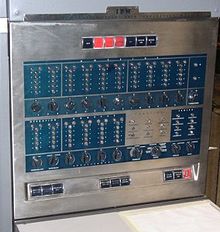Biquinary_code
Bi-quinary coded decimal
Numeral encoding scheme
Bi-quinary coded decimal is a numeral encoding scheme used in many abacuses and in some early computers, including the Colossus.[2] The term bi-quinary indicates that the code comprises both a two-state (bi) and a five-state (quinary) component. The encoding resembles that used by many abacuses, with four beads indicating the five values either from 0 through 4 or from 5 through 9 and another bead indicating which of those ranges (which can alternatively be thought of as +5).
Several human languages, most notably Fula and Wolof also use biquinary systems. For example, the Fula word for 6, jowi e go'o, literally means five [plus] one. Roman numerals use a symbolic, rather than positional, bi-quinary base, even though Latin is completely decimal.
The Korean finger counting system Chisanbop uses a bi-quinary system, where each finger represents a one and a thumb represents a five, allowing one to count from 0 to 99 with two hands.
One advantage of one bi-quinary encoding scheme on digital computers is that it must have 2 bits set (one in the binary field and one in the quinary field), providing a built in checksum to verify if the number is valid or not. (Stuck bits happened frequently with computers using mechanical relays.)

